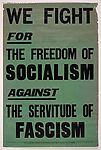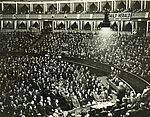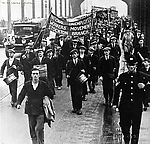 TUC anti-fascist poster, 1933
TUC anti-fascist poster, 1933 TUC anti-Nazi Demonstration, Albert Hall, April 1933
TUC anti-Nazi Demonstration, Albert Hall, April 1933 National Unemployed Workers' Movement March, 1933
National Unemployed Workers' Movement March, 1933 County Express 2/3/35
County Express 2/3/35

In Britain, as in Europe, the years of the Depression saw an increase in support for extremist groups, who proposed radical solutions to the economic and social problems. There was significant growth on the extreme left wing in the shape of the Communist Party of Great Britain (CPGB) and on the far right with Oswald Mosley’s British Union of Fascists (BUF).
The 1930s are known as the "Fascist decade", because of the impact of the Great Depression on European countries. It was an economic recession of such range and severity that it appeared to contemporaries to challenge the political and social order, and led some to question the credibility of capitalism and parliamentary and political systems. Fascist movements proliferated throughout Europe, having the greatest impact in Italy and Germany.
The great hope for British Fascism was the movement led by Sir Oswald Mosley, a charismatic baronet with a chequered history. He became a Tory MP in 1918, an Independent MP in 1922 and a Labour MP in 1926. As a minister in the second Labour government in 1929 he proposed radical measures to solve the rapidly worsening unemployment crisis. When the Government rejected his "Mosley Memorandum", containing proposals for solving the great social problems of 1930s Britain, he left the party and formed the New Party in 1931.
Moseley saw himself as a second Mussolini, and by early 1934 had recruited 50,000 members to his newly named British Union of Fascists (BUF). However, he was unable to create the political circumstances that had permitted the Fascist seizure of power in Italy, and strong anti-Fascist feeling had been growing in Britain since early in 1933. A downturn in support came in June 1934, following a BUF rally at London’s Olympia, when Fascist stewards brutally beat hecklers. The Daily Telegraph reported that, “Wild Scenes such as have not been witnessed in London since the worst days of the Suffragist agitation, occurred both outside and inside Olympia….Blackshirts and Communists fought fiercely both before and during the meeting. Fifteen hundred police, both mounted and foot, were on duty, and on occasions had to draw their batons in an attempt to quell the disturbances.” The Olympia rally brought widespread condemnation of the BUF, and by the end of 1935 membership had plummeted to just 5,000.
More successful was the BUF’s localised campaign in the East End of London. In the midst of Britain’s biggest Jewish community the BUF played up its anti-Semitism, recruiting thugs and bigots such as the infamous ‘Mick’ Clarke. By November 1936 national BUF membership stood at 15,500, perhaps as many as half of these members were in East London. However, anti-Fascists were determined that the ‘Blackshirts’ would be denied control of the East End’s streets. At the Battle of Cable Street, on October 4th 1936, a quarter of a million anti-Fascists thronged the area in opposition to a planned march by 7,000 BUF supporters. The BUF was obliged to call off the demonstration.
In local elections in 1937 the BUF stood in several parts of the country but did not win a single seat. During 1938 and 1939 the BUF campaigned energetically for peace with Hitler, but the party remained small and isolated.
The Communist Party of Great Britain (CPGB) was formed in August 1920 with the aim of bringing about a workers’ revolution. In the1920s the CPGB tried to work through the Labour Party, but they were marginalized and their attempts to affiliate were rejected.
The Depression of the 1930s worked to the Communists’ advantage in that their appeal was direct and attractive to many working class men and middle class intellectuals, recruiting most famously perhaps the bevy of spies from Cambridge University, including Philby, Burgess and Maclean. The end of Capitalism seemed near and their radical solution of a workers’ revolution had a sympathetic reception.
They campaigned for the unemployed, rallied support against the fascists, disassociated themselves from the failures of the Labour government between 1929 and 1931 and resumed activity through the trade union movement.
However, Communism was not strong enough in the 1930s to provoke the establishment of a counter movement, despite the CPG having fielded 25 candidates in the 1929 general election. It had been discredited by association with the USSR and the Stalinist purges. Communist membership had risen to 11,500 in late 1926, in the aftermath of the General Strike, but then fell to below 3,000 in 1930. There was a gradual rise in membership to around 18,000 in December 1938. Numbers in France and Germany at the time were far higher.
Despite having limited success in the country as a whole, the CPGB was, nevertheless, at the forefront of campaigns in support of the unemployed and against the Means Test. The Communist inspired National Unemployed Workers’ Movement (NUWM) was established in 1921 with the appointment of Walter Hannington as national organiser. It campaigned for the next twenty-five years under the slogan ‘Work or Full Maintenance’, and was the most confrontational of the groups, which emerged to defend the rights of the unemployed during the inter-war period. The NUWM sought to raise the profile of the unemployment issue through hunger marches, factory raids to protest against overtime working and mass demonstrations aimed in particular at Poor Law Guardians.
The NUWM was largely under the control of the Communist Party and its leaders made no secret of their Communist affiliations. Attempts to gain affiliation to the TUC in the 1930s were refused, due to these Communist associations. At the height of their influence during the late 1920s and early 1930s the NUWM and its leadership were subject to police surveillance and continual harassment.
Clearly, the TUC feared the Communist influence in the NUWM and called on trade councils to boycott its demonstrations and instead establish local unemployed associations. In 1933 the TUC organised a massive national demonstration against unemployment in 21 towns and cities throughout Britain. The TUC’s attitude to both the Communists and the Fascists is summed up in its 1933 annual report. The TUC’s first duty, it states, “is to affirm its adherence to the democratic spirit, which has made its existence possible. It must oppose equally all dictatorships whether to the Right or to the Left. The institutions of the Trade Union Movement are the most democratic of any in society. It could not exist as a voluntary combination of workers except by being responsive to the aspirations of its members. It cannot exist in an atmosphere of dictatorship, nor will any dictatorship allow it to exercise its function as an independent, protective organisation acting in accordance with the desires of its members. There can be no industrial democracy under dictatorship. There is no real freedom of expression either in the Press or on the platform. Strikes are regarded as an act against the State itself.”
Despite the activities of extremist political groups, the National Government continued to enjoy the support of the majority of the British public throughout the 1930s. There was no cultural rejection of authority itself, as there had been in Ireland. Britain’s inter-war economic and social crisis was real enough, but its dimensions were very different from those of crises experienced in continental Europe. Although some parts of the United Kingdom suffered appallingly from the effects of long-term economic decline, others saw the growth of new industries and new prosperity. Britain’s unemployment problem was significantly less acute than that in mainland Europe and, despite the many faults of Britain’s benefit system, it was enough to ensure that the unemployed were not the political tinder they became elsewhere.
Rollover the captions in the box to see the available images in thumbnail format, click the caption to see the full-size image
| Reference: | 719 |
| Keywords: | |
| Archive Ref: | |
| Updated: | Wed 9 Jul 2008 - 10 |
| Interpretation written by | Barbara Harris |
| Author's organisation | Curatorial |
| Organisation's website |